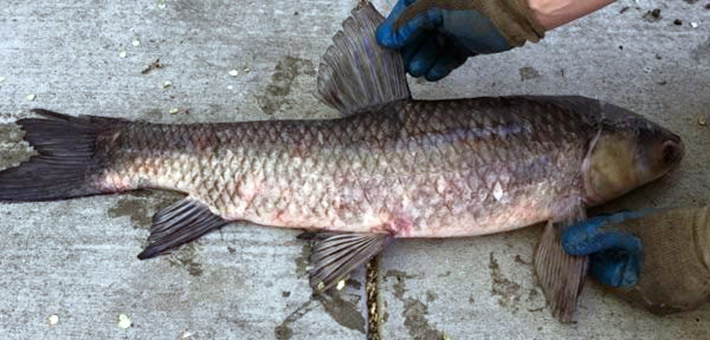Black Carp Bounty Leads to Discovery in Illinois River
Commercial fishers helping resource agencies detect black carp
Updated May 24, 2017

Black carp found at river mile 137 of Illinois River in April of 2017. Photo courtesy of Aaron Roberts
A black carp captured this April in the Illinois River by a commercial fisher highlights a unique partnership between fishers, the Illinois Department of Natural Resources, and Southern Illinois University. For surrendering this black carp, the commercial fisher received a $100 bounty, and in turn, helped resource agencies learn a little more about the range of black carp in the Illinois River. The black carp was found south of Peoria, Illinois near Copperas Creek Lock and extends the upstream detection of the species by 110 miles.
Scientists from federal agencies including the U.S. Fish and Wildlife Service and U.S. Geological Survey provide valuable analysis of the surrendered black carps. The most recent black carp reported near Peoria, Illinois was 28 inches in length and weighed eight pounds. Analysis by the U.S. Fish and Wildlife Service indicates that this fish was fertile, referred to as diploid, which is consistent with most fish recently captured in the bounty program. Since the establishment of the bounty program in 2015, 37 black carps have been collected. Of these, 26 were collected in 2016 alone. Four have been found in the Illinois River.
Commercial fishers are valuable in the cooperative effort to better understand black carp because they are skilled in fishing large rivers throughout the region. Beyond the Illinois River, the bounty program also accounts for the majority of adult black carp reported in the rest of the country. In addition to commercial fishers, recreational anglers and bowfishers should be aware of these invasive fish and what to do if one is harvested. In appearance, black carp closely resemble the more common grass carp, another Asian carp which is also found in large rivers of the central United States. Proper identification of black carps is an essential component of the bounty program.
The black carp is one of four species of Asian carp that threaten waterways in the central United States. As molluscivores, black carps consume native freshwater mussels and snails that live in our large rivers. 26 freshwater mussel species native to Illinois are state-threatened or endangered, twelve of which are federally listed. The Asian Carp Regional Coordinating Committee’s collaborative 2017 Asian Carp Action Plan recognizes the informational needs for black carp control and management, and is further addressing this need in the annual Monitoring and Response Plan which focuses on the upper Illinois Waterway.
More information on black carp and black carp distribution in the United States:
U.S. Geological Survey Animated Map*
U.S. Geological Survey Black Carp Fact Sheet
Identification of Black Carp and Grass Carp
To report a Black Carp captured in the central United States from the Mississippi, Illinois, Ohio or Wabash rivers, please call a number below during regular business hours or report to your local natural resource agency. Fish should be held cold, on ice, not alive, until passed to a natural resource agent.
Illinois DNR: 217.557.0719 OR 618.462.0362
Southern Illinois University: 618.453.6089
U.S. Geological Survey: 573.876.1866
*Updated on May 23, 2017 to reflect the reported capture of a black carp at Douglas Lake near Chillicothe, Illinois, adjacent to the Illinois River at approximately river mile 182. The report was from a commercial fisher, although no specimen was provided. More information can be found on U.S. Geological Survey's Nonindigenous Aquatic Species page.
